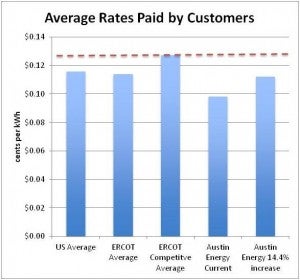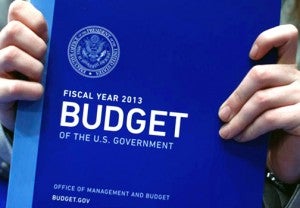Austin Energy’s Residential Rates: 12% Below the Average Rate in ERCOT’s Competitive Markets – After Accounting for the Proposed 14.4% Rate Increase
Austin Energy has been in the news a lot lately, and most often for some controversy around the ongoing rate review process. What often gets lost in these heated discussions is that fact that Austin’s heritage of clean energy and innovative approaches to economic development are firmly rooted in our city’s electric utility, and that the utility allows city leaders to keep taxes low. At the same time, Austin Energy’s leadership often puts it in the crosshairs of groups that are ideologically opposed to clean energy and city owned utilities, and whether supported by facts or not, the opportunity to criticize Austin Energy has proven too difficult to resist.
The Texas Public Policy Foundation (TPPF) is often one of the ringleaders in the crusade against clean energy as well as city owned utilities, and they’re not going to let facts get in the way of scoring an ideological point. In knocking Austin Energy and promoting their agenda, TPPF cherry picks data and uses coded language like the idea that customers “can choose” rates lower than Austin Energy’s if they are in the competitive regions of the Electric Reliability Council of Texas (ERCOT). The truth is, for a customer in the competitive areas of ERCOT to maintain lower rates than Austin Energy they would have to change electric providers each month, and they’d have to be pretty lucky on top of it.
The problem is that the rates TPPF reference when they say customers can choose lower rates are usually introductory, variable or otherwise subject to increases not included in the rates that customers do choose. What this means is that customers actually pay more than TPPF’s selective math would suggest, but TPPF seems more concerned with scoring political points than what customers actually pay for their electricity.
Look at the data from a more logical point of view and you will see that competitive regions in ERCOT average higher residential rates than ERCOT’s average rates. In fact, ERCOT rates are kept low largely by municipal and co-operative utilities like Austin Energy, the customer owned utility model that TPPF criticizes in their latest missive. The most recent data available for a real analysis of the rates Texans pay was released by the Energy Information Administration just a few months ago, including data through 2010. As the chart below shows, Austin Energy’s rates are well below the ERCOT average, and even farther below the average competitive market rate, despite TPPF’s claims to the contrary.
Even if you account for Austin’s proposed 14.4% residential rate increase through 2015, the the new rates are 12% below current competitive rates in ERCOT. This calculation doesn’t even take into account the fact that nominal retail energy prices in ERCOT are projected to go up by 11% by 2015 according to the Energy Information Administration. Taking this projected rate increase into account it’s clear that Austin Energy’s rates – even after the rate review is completed – will be below the competitive average.
As we talk about rates in our community and across Texas, it’s important to remain focused on factual analysis and avoid misleading assumptions driven more by ideology than a desire for real debate. Unfortunately, arguments like those put forward by TPPF don’t contribute to an honest discourse; they mislead the public, distort reality, and threaten Austinite’s low tax lifestyle.
















